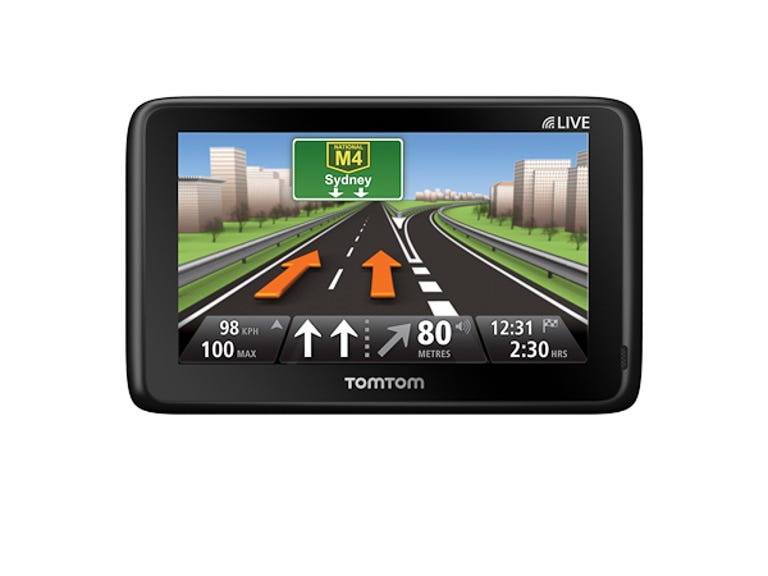 Why You Can Trust CNET
Why You Can Trust CNET TomTom Go Live 2050 review: TomTom Go Live 2050
If you're planning on driving across Europe and North America, the 35-map World edition of the Go Live 2050 is possibly the GPS bargain of the year. If not, there are better specified and better value sat nav units on the market.
Design
It may be thinner (19mm versus 21.7mm) than its cheaper resistive touchscreen brother, Go Live 825, but the Go Live 2050 looks and feels chunkier. The blame here falls squarely on the shoulders of the 2050's rounded bar-of-soap body. To liven up proceedings there's a bit of body jewellery in the form of a slab of a brushed metal appliqué on the rear. A narrow translucent power button sits along the top left-hand edge of the 2050 and glows orange or green, depending on the state of the battery, but it often takes a few attempts for the power button to register the intent of your prodding.
The Good
The Bad
The Bottom Line
Unlike most other TomTom devices, the Go Live 2050 doesn't have a windshield suction cup that's built into the body of the device. Rather, the cup is part of the in-car charging cradle and features a set of magnets that not only hold the Go Live 2050 firmly in place, but also allows the unit to be snapped in and out. As a piece of design, it's pretty nifty and should please those who prefer to tap in a destination while having the device in their lap.
As compensation for the seemingly chubbier body, there's a glossy capacitive touchscreen that's multi-touch capable, although support for multi-touch gestures is limited to the menu system and the map overview screen. Unfortunately, the upgrade in screen technology is not accompanied by a bump in resolution — the Go Live 2050 features the same 480x272 resolution and jagged fonts seen on entry-level 4.3-inch units.
The glossy screen improves the unit's apparent brightness and contrast, but increases the amount of fiddling required, as sunrises, sunsets, light coloured interiors and sunroofs all cause annoying and distracting reflections. Compared with pedestrian TomTom units, which feature a built-in suction cup, the swivel mount on the Go Live 2050 is significantly stiffer, and unless you grasp both device and mount, there's a fair chance of detaching one from the other.
Features
There are two versions of the Go Live 2050 on sale, locally: a AU$399 version loaded with Whereis' map of Australia, and a AU$499 World edition that comes with complete map coverage for 35 nations, including Australia, New Zealand, western Europe, the United States and Canada. There's also partial coverage for seven countries, including Russia and Turkey, and connecting roads for a further seven countries in eastern Europe. If you're a regular traveller to and driver in the covered countries, the "world" version represents excellent value as overseas GPS maps will often set you back around AU$100, per country.
Bluetooth hands-free is standard and makes full use of the higher fidelity speaker fitted to the Go Live 2050. Voice recognition is present too, but its implementation and usefulness are rather limited. Compared to the excellent Garmin system in its 2012 range, the TomTom system isn't voice activated, instead requiring the user to tap an on-screen microphone button. Other constraints include its lack of on-screen guidance, inability to verbally choose from a list of options and a poor recognition rate — even on unchallenging names, the TomTom successfully guessed the meaning of our utterances less than 50 per cent of the time.
Performance
The Australian Whereis map features lane guidance for almost all multi-lane roads in capital cities and full screen junction view imagery for some major intersections, as well as highway and motorway exits. Street names are spoken aloud, but the TomTom often mispronounces titles that have an Aboriginal origin. To help smooth out any map errors, drivers can mark down and upload errors, such as incorrect speed limits, missing road restrictions and the like, as well as download crowd-sourced corrections from TomTom's MapShare service. Unfortunately, transferring MapShare data can't be done over-the-air, as it requires a PC or Mac with the MyTomTom applet installed.
When roaming around Australia, the Go Live 2050 has access to TomTom's suite of Live data services that include Google location searching, weather and, most importantly, TomTom's traffic information service, dubbed HD Traffic. Operating over the mobile phone network, TomTom Live is free to use for the first year and then AU$69.99 per annum, after that. We're not sure, though, that TomTom's traffic service is AU$70 a year better than the free-after-purchase Suna traffic messaging system that's included with most mid-range and higher Garmins and Navmans. While TomTom's HD Traffic claims to receive information updates twice as frequently (at two minute intervals) as Suna-equipped devices, on occasion, we still ran into traffic jams that had yet to appear on the system, while at other times, we were warned about delays that had already cleared.
Route calculation times are slower than on cheaper TomTom devices, primarily thanks to the unit having to consider data from the HD Traffic service. The routes, themselves, do nothing to distinguish itself from the throng — the Go Live 2050 will get you to your destination, but the route may fall well short of being the fastest or most logical.
Conclusion
If you're planning on travelling across Europe and North America and plan on driving, the 35-map World edition of the Go Live 2050 is possibly the GPS bargain of the year. If not, there are better specified and better value sat nav units on the market.


